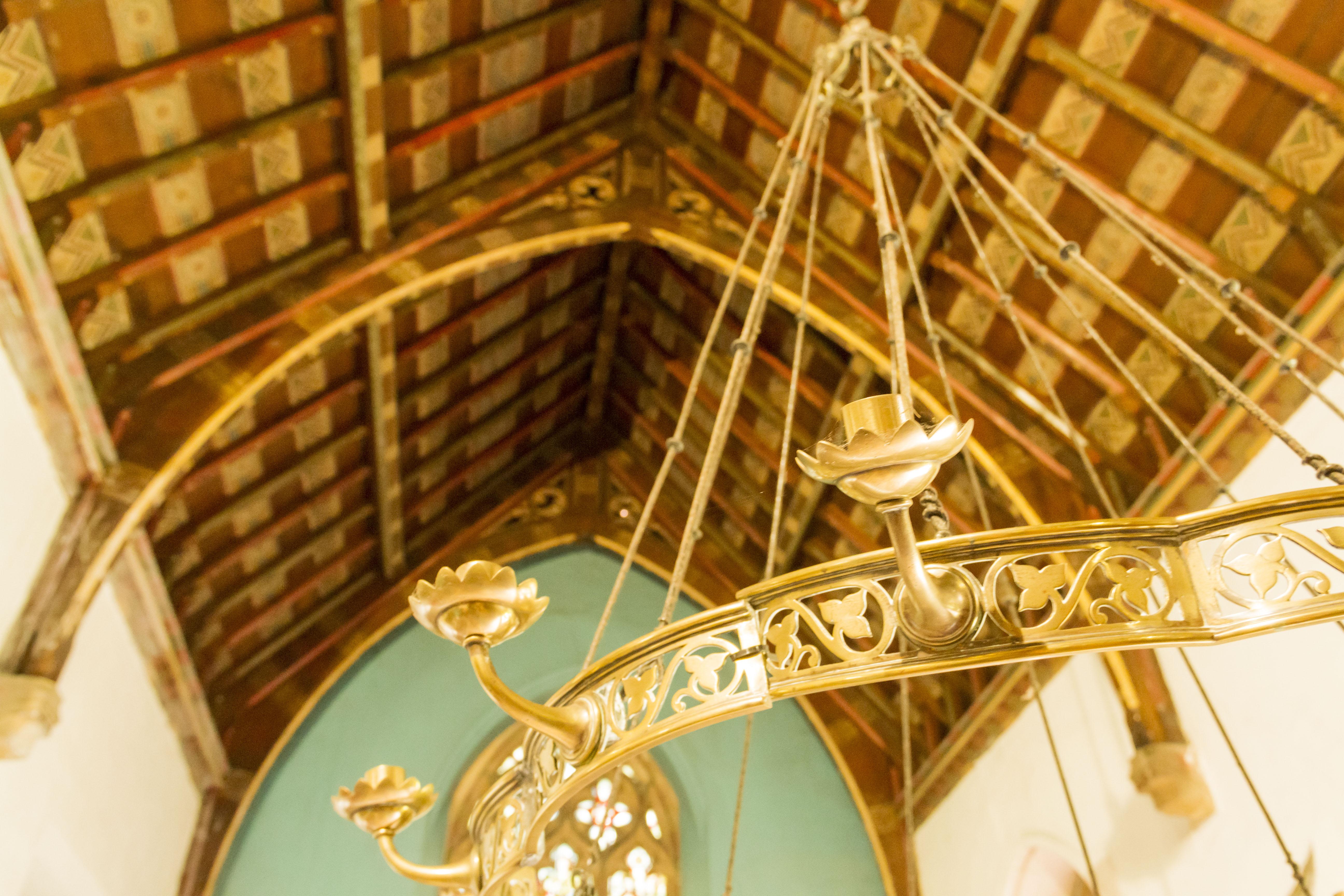
Intriguing insides
Churches are literally 'treasure houses' of history.
Inside they are troves of artwork and symbolism relating to the spiritual life of the church and its congregation; tombs and memorials showing the changes in style and fashion of the departed rich and their families. The day to day fixtures such as the font, pulpit, reredos screen and lectern, are all lit by the daylight streaming in through the stained glass windows.
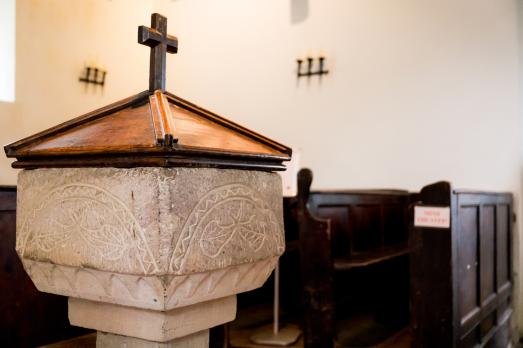
Font
Every medieval church contained a font. It was close to the main entrance of the church in an area known as the baptistry. Today, fonts may be found elsewhere in the church. The word font is derived from the Latin word 'fons' which means spring.
The font contains the holy water used in Baptism. They were originally large enough to allow the infant to be fully immersed, but in the middle ages it became the practice to baptise by partial immersion or pouring water over the head.
In 1236 it was ordered that all fonts should have a lockable lid. The water was generally only changed once per year, on Easter Sunday!
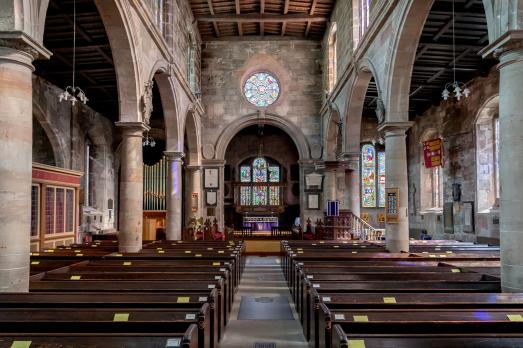
Nave
Derived from the Latin word 'navis', meaning ship. It was thought that the nave roof resembled an upside down ship, or the Ark of Salvation.
The nave is the main body of the church. Originally, the nave was unconsecrated and its maintenance was the responsibility of the congregation. The nave was used for many functions. In early days it was the scene of trial by ordeal, storage space for the arms which every parish had to provide (the regimental colours found in many churches remind us of this) and a venue for guild plays, processions, church ales and business.

Wall painting
In the middle ages, the interior walls of churches were like picture books of painted plaster. They were used as visual aids for the illiterate congregation. Walls were covered with murals depicting saints and scenes from the scriptures.
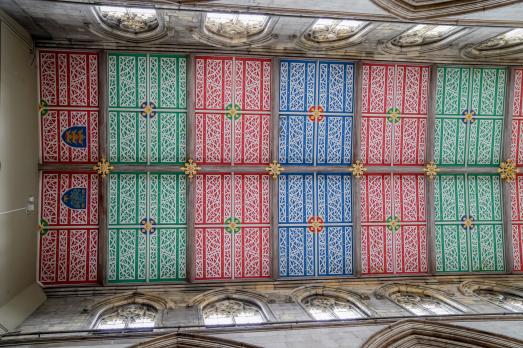
Roof boss
A boss is a decoration in stone or wood where cross members of a roof or ceiling intersect.
Many are elaborately carved, and popular subjects include grotesque and human faces, green men, symbols of Christ’s passion, heraldic shields, foliage and animals. For most of them, the original paintwork has long since gone, to be replaced in some cases by a covering of gilt paint.
Green man
The Green Man is one of the most powerful and enduring pagan symbols and was originally a Celtic fertility symbol.
Green Men are found in a variety of forms in the ornamental stonework and woodwork of churches. They are male heads peering through foliage, which is often growing from their eyes, mouth, ears and nostrils. They are usually found on roof bosses, capitals, corbels and misericords.
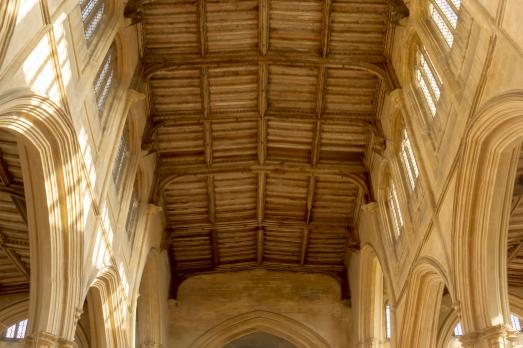
Clerestories
In larger churches, the upper level of the nave wall was often pierced by windows to increase the amount of light. When aisles were added in medieval times, many churches raised the nave wall, so that a clerestory could be installed.
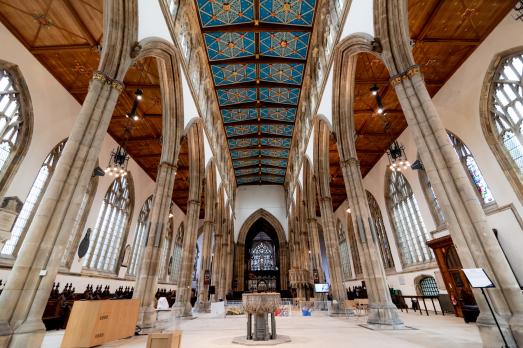
Arcade & columns
An arcade is a range of arches supported on piers or columns. The term is also used to describe the arched division between the nave of a church and its aisles.
Arcades rest on columns. The first columns would have been made of wood. They are like trees and remind us of ancient pagan beliefs and practices.
Capitals, the top part of columns, are often carved with leaves or other similar decorations, reinforcing the connection with trees.

Aisle
The word aisle comes from the Latin 'ala' meaning wing.
An aisle is a sideways extension of a nave, from which it is divided by an arcade of arches. Some churches were built with aisles, but they were usually added to earlier buildings, perhaps to accommodate the growing population.
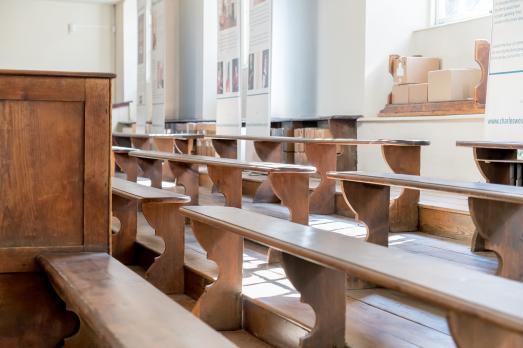
Seating
For centuries there was no seating in the nave, although a stone ledge was sometimes provided for the elderly and infirm; 'the weakest go to the wall'.
With the increase in preaching came the need for seating. By the late 16th century an increasing number of churches had installed permanent benches.
Rows of benches are often erroneously referred to as pews. Pews are actually enclosed structures, and of a much later date and had doors to protect from drafts. These ‘box pews’ were sometimes provided with armchairs and cushions and perhaps even a stove and curtains.
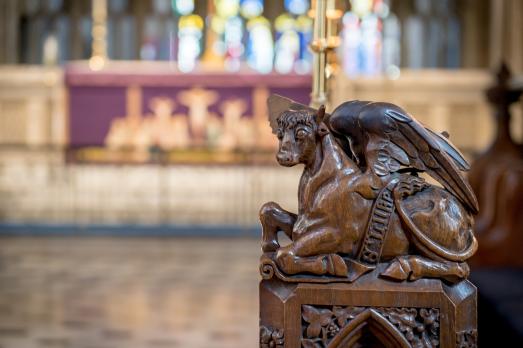
Poppyhead
Poppyheads are ornaments, often found on top of the upright end of seats and benches.
They may be carved in the shape of figures, animals, beasts, foliage, or a number of other shapes.
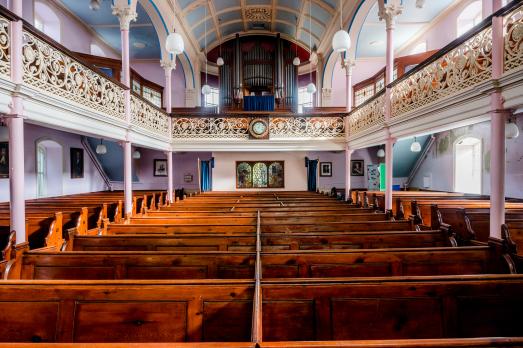
Gallery
A gallery is an upper storey constructed to provide additional seating for the church.
Side galleries, to the north and south of the nave, were erected in many churches in the 18th and early 19th centuries to accommodate the greatly increasing population of the industrial revolution, and later taken down when church congregations began to decrease.
Many churches also have west galleries, in the space beneath the tower, which were intended to accommodate choirs and musicians. Later, church organs were often placed in the west gallery.
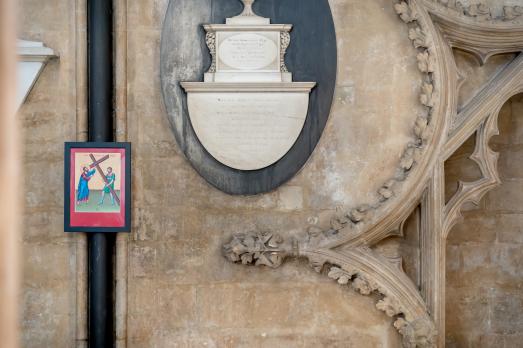
Stations of the cross
Sometimes depicted in a series of paintings or carvings round the walls of a church.
They represent the fourteen incidents which occurred in Christ’s last journey from His meeting with Pilate to His entombment. During a devotion of the same name, each station is visited in turn.
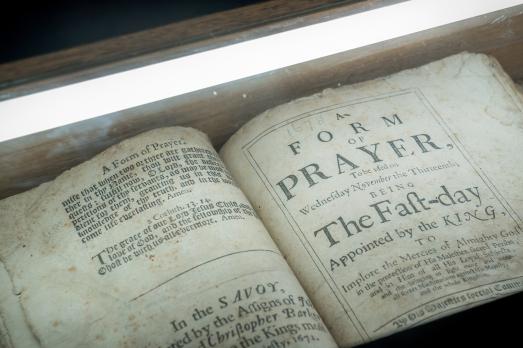
Chained bible
Over 450 years ago, King Henry VIII declared that a large copy of the English Bible should be set up on a lectern in every parish church in England, so that the poor as well as the rich might hear the Word of the Lord.
To guard against theft, the bibles were chained securely.
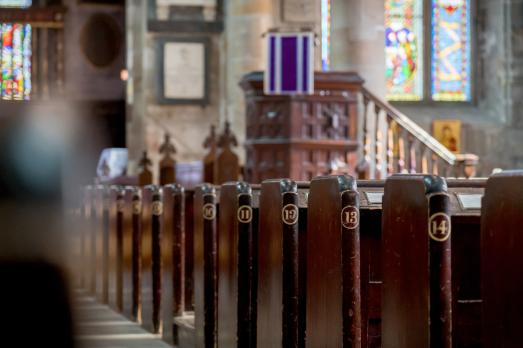
Pulpit
The oldest mention of a pulpit in England dates from the 12th century. The oldest example still in existence is believed to date from about 1330. In the 15th century, only a fifth of churches had a pulpit, but in 1603 they were made compulsory.
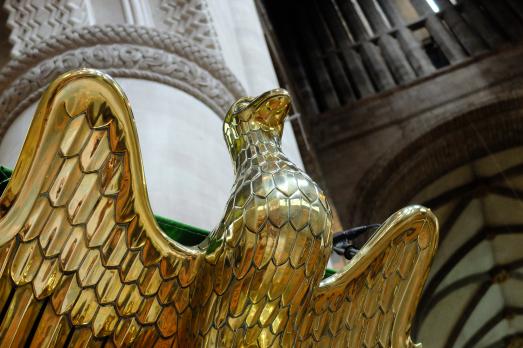
Lectern
The lectern is a reading desk on which the bible rests.
It is usually made from brass or wood, and is moveable. Brass lecterns are usually in the shape of an eagle with outstretched wings. The eagle often stands on a ball which represents the world, while the bible on the eagle's back symbolises the gospel being carried to the corners of the earth.
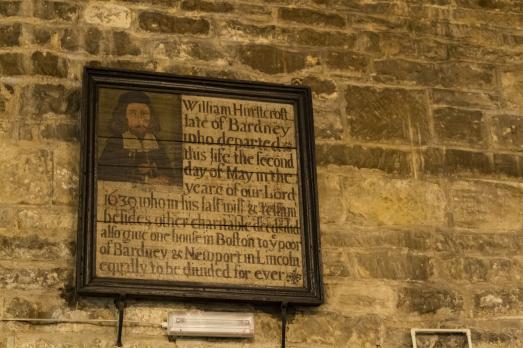
Bequest boards
Bequest boards hang on the walls of the church, usually in the nave. They list gifts of money made to local charities. Bequest boards also give an idea of the changing worth of money over time.
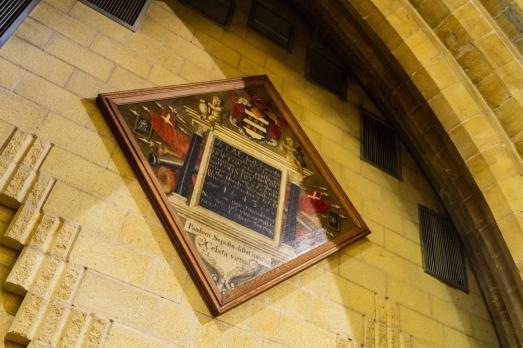
Hatchment
A hatchment is a diamond-shaped board made of wood or wood and canvas.
It bears the arms, crest or motto of a deceased person.
Hatchments were carried in front of funeral processions to the church, and afterwards hung on the gate of the deceased person's house. After it had been hung on the gates for several months, it was taken down and hung in the church.
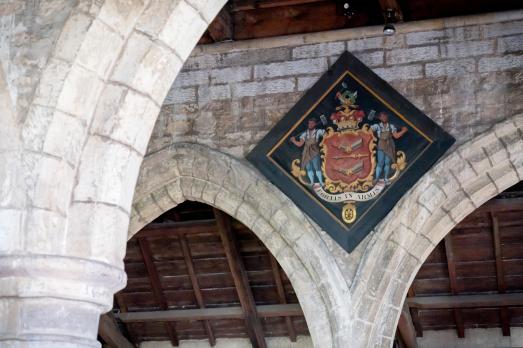
Royal coats of arms
After the Pope granted Henry VIII the title 'Defender of the Faith', Royal coats of arms of the king or queen of the day were hung in churches. They were there to remind congregations of the link between the church and the state.
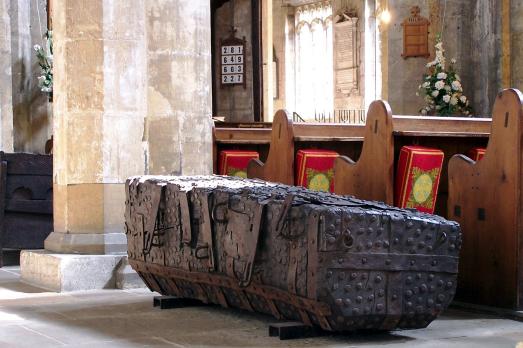
Parish chest
For hundreds of years, large chests with slots in the top were used for the collecting alms.Chests were also used for keeping parish registers, accounts, and other records.
They usually had three or more locks, each with a separate key held by a different person. All had to be present to unlock the chest.
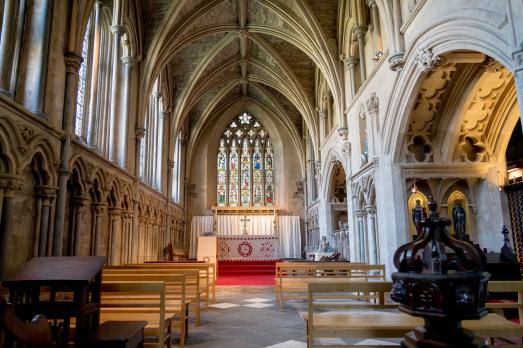
Chapels and chantry chapels
Chapels:
The term chapel came to be used for sanctuaries where Holy Relics were preserved and where prayers were said. From around 88 AD it was also used for sacred buildings with a status less than that of a church.
Chantry chapels:
By the 15th century most large churches had at least one chantry chapel, in which a priest was employed to sing masses for the soul of the founder of the chapel and others nominated by him. In town churches chantry chapels were often supported by trade guilds for the benefit of their members. Chantry chapels were abolished at the time of the Reformation.
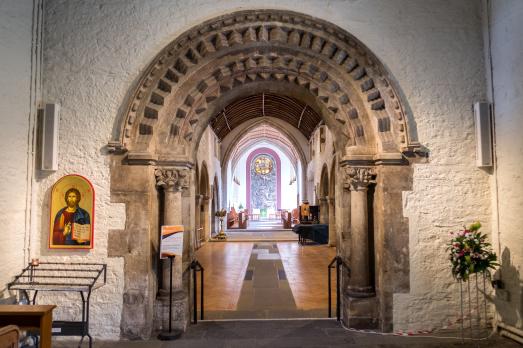
Chancel arch
The arched opening in the east wall of the nave, providing access to the chancel. The chancel arch is often decorated with carving, which may once have been painted.

Rood screen, great rood and rood loft
Rood screen:
In medieval churches, the rood screen was a decorative stone or wooden screen which separated the nave from the chancel, and had a central gate. Most were pierced with a lattice work of carved wood and richly decorated. Other screens were used to separate chapels from the chancel or aisles.
Great rood:
A rood is a carved image of Christ on the cross, made of wood or stone. The medieval 'great rood' was a carved and painted crucifix, erected on a pedestal above the rood screen. It had the figures of the Blessed Virgin Mary and St John the Evangelist on either side of Jesus on the cross.
Rood loft:
Many medieval churches had a rood loft, or singing gallery, on top of the rood screen. It was often supported by a coving. In most cases the only evidence left that these existed are the blocked up doorways that led to them.
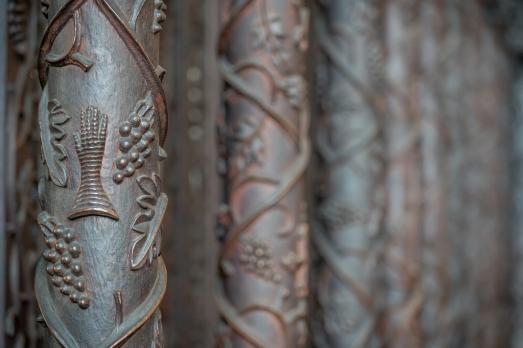
Instruments of Christ's passion
Representations of the Instruments of Christ’s Passion are displayed in many churches, with the object of remembering Christ’s suffering for the redemption of mankind. These can be in stained glass windows, on roof bosses, on reredos screens, or painted onto a number of small shields.
Instruments shown include the cross, the crown of thorns, lances, hammer and nails, scourges, and the robe which Christ wore.
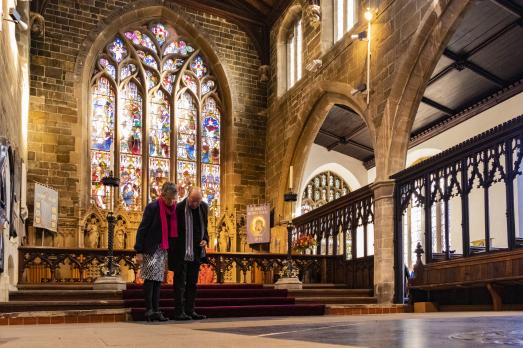
Chancel
Chancel derives from the Latin 'cancelli', meaning grating or lattice.
The term is used to describe a presbytery which is separated from the nave by a rood screen. From 1215, it was considered necessary to enclose the chancel by a screen - 'to preserve the mystery of the Eucharist' and to separate the holy part of the church from the sometimes rowdy secular activities of the nave.
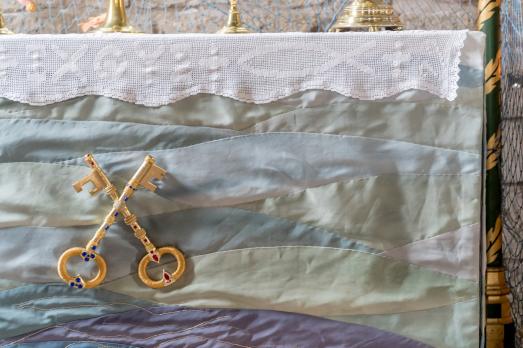
Altar and reredos
Altar:
The altar is the heart of the church. It usually stands at the east end of the chancel or presbytery, in an area known as the sanctuary. The altar has two principal symbolic meanings. First, it is a sacrificial altar. Christian writers saw Jesus as a sacrificed lamb in his crucifixion and the altar remembers that sacrifice. Second, it is a table for a communal meal, remembering the last supper. The altar is frequently marked by five crosses, referring to the five wounds of Christ.
Reredos:
Behind the altar may be a reredos screen. It can be a curtain, a picture or carvings in stone or wood. Sometimes it has niches containing figures of saints.
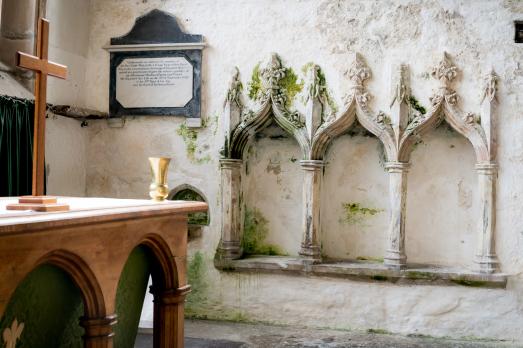
Sedilia & piscina
Sedilia:
These are recessed seats, usually three, for priests. They are usually set into the south wall of the chancel, are made of stone and may be canopied.
Piscina:
The Latin word 'piscina' literally means fish pond.
The piscina is a niche containing a shallow stone basin with a drain hole. It was used for disposing of the holy water used to wash the communion vessels during the service. A double piscina also has a bowl for the priest to wash his hands.
Easter sepulchre & aumbrey
Easter sepulchre:
Easter is the most important festival of the Christian year. An Easter sepulchre is a recess, usually in the north wall of the sanctuary. At Easter time it is symbolic of Jesus' burial in the tomb following the crucifixion.
Aumbrey:
An aumbry is a small, secure chest or cupboard in a wall, usually the north wall near to the altar. It houses the sacred vessels used during the service and communion. Today, aumbries are often used to store the Blessed Sacrament.
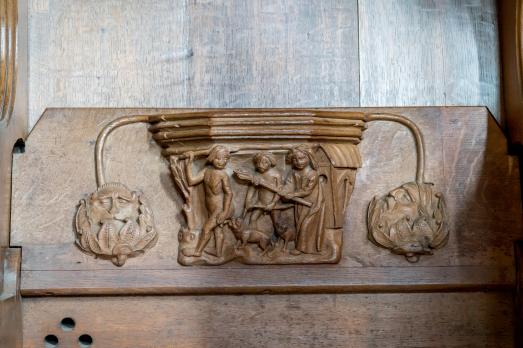
Misericord
Some church stalls have misericords. They are hinged, tip up wooden seats which, when up, have a second smaller seat on the underside for the user to rest on when standing position.
Sometimes the misericord seat has carved decorations.
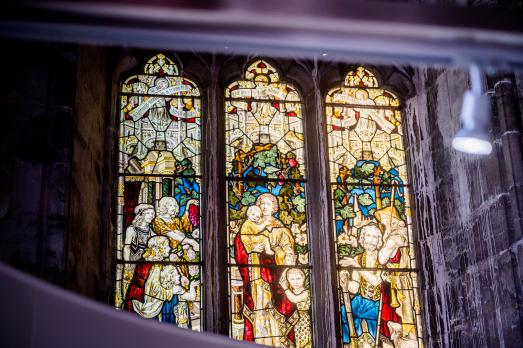
Stained glass
Stained glass is used to add beauty and colour to churches. Often windows show biblical scenes.
Most medieval stained glass was lost following the Reformation and during the Civil War, when it was smashed by the iconoclasts.
There was a revival of interest in stained glass during the Victorian era, and much of what we see today is from that time. Victorian stained glass was usually installed as a memorial to local people or to commemorate significant events.
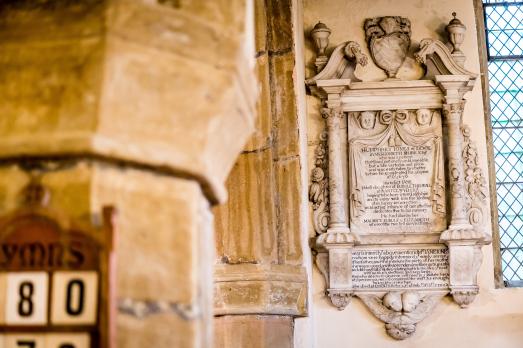
Memorials
The ‘great and good’ of society enjoyed the privilege of being commemorated within their parish churches. It should be remembered that monuments do not necessarily mark the place of interment, which may be some distance away.
Monuments can provide a wealth of information concerning those remembered; wealth, fashion, their appearance, the way people lived, and how they hoped to be remembered. Memorials vary in size from large, elaborate, canopied monuments to modest tablets fixed to the church wall. From the beginning of the 13th century the image was often placed on a tomb chest and carved in the form of a three dimensional effigy.
